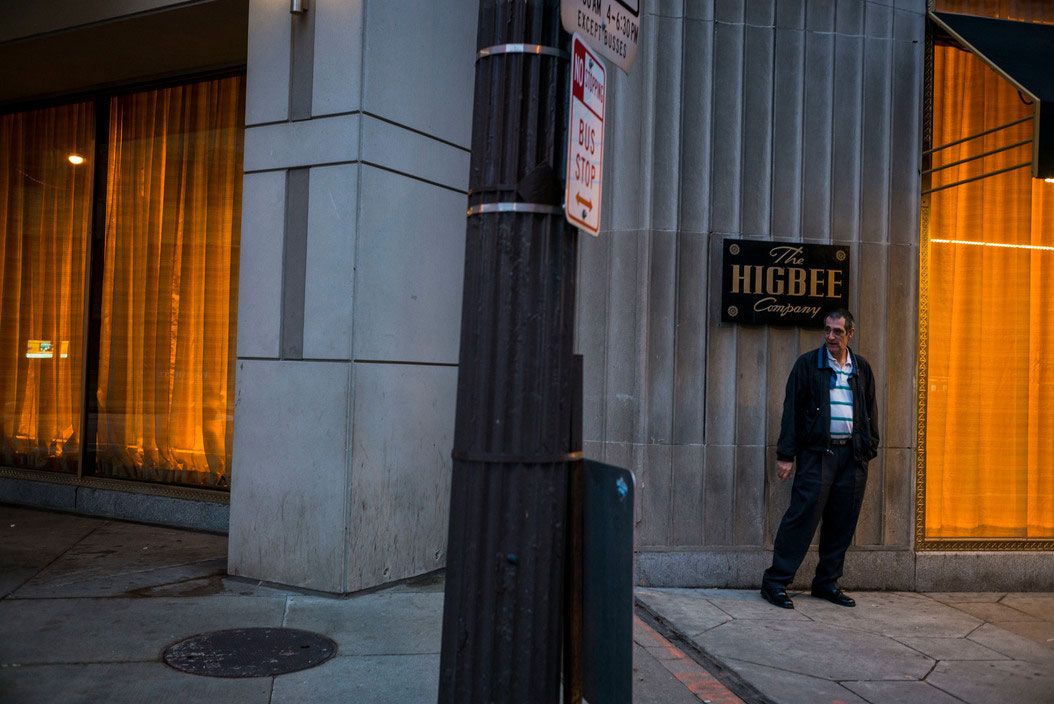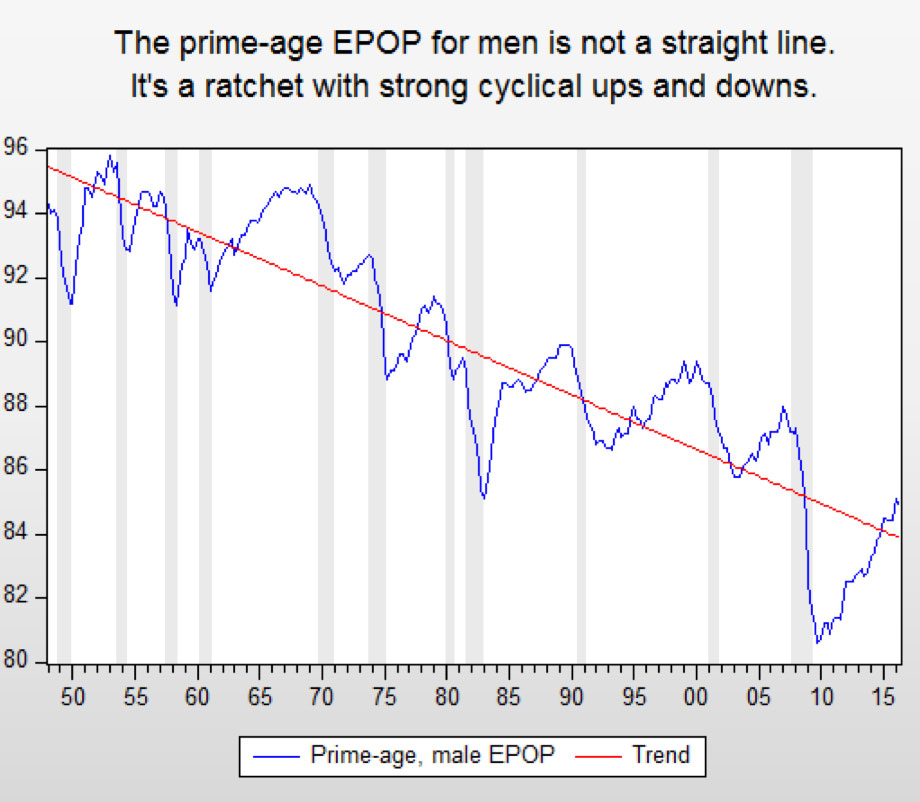This year’s election has presented an economic mystery: why, given an apparently healthy US economy, are there so many voters, on both sides of the political spectrum, looking for dramatic change? Over the last few years, official unemployment figures have declined to pre-recession levels. And just this week, new economic data showed that households all across the income scale made more money in 2015. Yet, anti-establishment candidates like Donald Trump and Bernie Sanders have drawn surprisingly strong support.
One answer is suggested by the title of Nicholas Eberstadt’s new book, Men Without Work: America’s Invisible Crisis. With such a headline, you would think it is about bitter unemployed or low-paid workers in America—in Eberstadt’s analysis, particularly white men. Indeed, few Americans are convinced that the official unemployment rate of 5 percent gives an accurate picture of the labor market today. Dissatisfaction among workers runs high, with stagnating wages and long bouts of unemployment common. Estimates suggest that the real unemployment rate is more like 10 percent if we take into account those who stopped looking for work or those who can only find part-time work.
Most disturbingly, as Eberstadt notes, while macroeconomic data may show a relatively healthy US economy, overall participation in the workforce—what is known as the employment-to-population ratio—is historically low. He focuses almost solely on the case for men. For example, only 84.3 percent of men aged twenty-five to fifty-four were working in 2015 compared to 94.1 percent in 1948. Taking a larger age group, only 68.2 percent of men twenty and older worked in 2015 compared to 85.8 percent in 1948. If work rates for men were the same today as in 1965, 10.5 million more men would be working today. One explanation for the decline is that many more are in school than in 1965, but that still leaves some 9.5 million fewer men at work, according to Eberstadt’s numbers. If they were out there working and making adequate salaries, the nation’s GDP would be significantly higher.
In fact, the falling employment ratio of men, and of indeed the entire work force, has been written about extensively. But Eberstadt has a different purpose in mustering these numbers. His new brief book is not really about our troubled labor market. Instead it is an attack on America’s too-generous social net, which he sees as the real culprit for low labor participation. Rather than a decline in jobs, Eberstadt defines the problem as a “flight from work.” He believes that men in particular are working in relatively fewer numbers—largely because America’s generous safety net enables them to do so.
A longtime fellow of the conservative American Enterprise Institute, Eberstadt is a respected scholar and writes in a cautious and moderate tone. He often cites those who disagree with him, including a solid study by President Obama’s Council of Economic Advisers that directly conflicts with his own analysis. But this even-handed approach is deceptive.
Released just as the presidential campaign enters its crucial final weeks, Men Without Work is clearly designed to stimulate discussion about how we are spoiling American workers and turning them into slackers. If Eberstadt’s analysis holds, Sanders’s ideas, like raising the minimum wage and imposing higher taxes on the wealthy, and Hillary Clinton’s increasingly long list of progressive social proposals, are the wrong medicine. What we need instead, he says, is more small business creation and fewer social giveaways. In particular, we should reduce disability insurance and what are known as means-tested anti-poverty programs, including food stamps and Medicaid, which Eberstadt says encourage sloth and low self-esteem. He is especially concerned with the increase of those receiving federal or state disability insurance benefits, which he suggests reflects a dangerous shift away from gainful employment among men especially.
This analysis seems likely to square well with Donald Trump’s economic policies, though Trump has made too few proposals to tell for sure. Trump says he won’t cut back Medicare or Social Security, for example. But he’s not likely to be sympathetic to expanded programs for the poor and unemployed. Indeed, he has said working wages are too high. And when he recently proposed a paid-leave program for women, he said he would pay for it at the expense of a purportedly fraudulent or inefficient unemployment insurance system.
So how do Eberstadt’s arguments hold up? There is indeed reason for concern about the male employment gap. And it is true that the existence of a safety net makes it easier for some workers to shirk. But Eberstadt’s focus is misleading. Consider disability benefits: even according to his own data, the growth of workers on disability is too small to account for much of the drop in labor market participation. The CEA report I cite above suggests it accounts for about 0.5 percent of the fall in participation.
Advertisement
In another example, Eberstadt cites a regular government survey about how time is spent by adults, apparently to show that unemployed men are slacking off. This is simply a rhetorical gambit, a cousin to Ronald Reagan’s “welfare queens.” The survey, he notes, shows that those out of work spend many more hours socializing than do those in work. What does he expect men who can’t find jobs to do?
In fact, economic data make clear that few men are “fleeing” work in order to get unemployment insurance, disability insurance, food stamps, and the like. To the contrary, new social programs beginning in the 1980s have made access to benefits increasingly dependent on working, not sloughing off. Though he does not acknowledge it, Eberstadt’s data suggest a different, far more powerful explanation of the employment gap: there are too few jobs for these men.
The evidence that undercuts Eberstadt’s argument is straightforward. Though he says the employment-to-population ratio has fallen more or less in a straight line for decades, it actually bobs up and down with the strength of the economy. Men Without Work includes responses to Eberstadt’s analysis by two colleagues, Henry Olsen, also from the American Enterprise Institute, and Jared Bernstein, Vice President Joe Biden’s former chief economist. Both stress that the employment-to-population ratio falls when there are fewer jobs available—what happens when growth turns negative in recessions. As shown in the below graph, created by Bernstein for a recent blog post, more people work when more jobs are available, pure and simple.
Moreover, as the CEA report notes, the big fall-off in labor market participation among men is concentrated among the least educated. The drop is rather small for those with a college education, while for those who only completed high school participation rates have plummeted. There are few good jobs for them. Availability of low-skilled jobs has declined and those that are available are increasingly poorly paid. If low-skill jobs were going unfilled, as Eberstadt suggests, wages would not have fallen so much.
The lack of low-skill jobs is a major reason why the decline in participation has continued over time. And the lowest employment-to-population ratios are among African Americans, who again, because they tend to have less access to higher education, qualify for jobs with meager wages if there are any such jobs at all.
Eberstadt also overlooks the fact that women, too, have disconnected from the work force in recent years. As economist Dean Baker points out, their employment to population ratio, while rising rapidly since the 1960s, has also fallen sharply since 2000.
This decline in female participation also suggests that lack of jobs, not flight from work, is the primary challenge. Indeed, the rapid rise in the proportion of women in the workforce between the 1960s and 2000 probably contributed to the long-term decline in male participation.
Another issue Eberstadt skirts is the nation’s high trade deficit, which may put substantial pressure on jobs and wages, especially for those at the low end. Thus we see that the low-end workers are understandably cut off from the labor market and account for a large portion of the decline in participation. More heart-breaking, the truly disconnected are the growing proportion of men who are or have been in prison and often can’t get jobs when they are released, as Eberstadt and others have observed. They have had a significant impact in the fall in male labor participation.
Perhaps the best indication that more jobs, rather than fewer benefits, are the answer can be found in the recent economic data. Interestingly, the employment ratio has regained two thirds of its losses since the Great Recession of 2009. Are men, or women for that matter, really fleeing work? Economic growth over time matters. There is a simple explanation for the substantial increase in household income shown in this week’s Census Bureau data: jobs are being created and wages are starting at last to rise. But we are not there yet. Household income is still below its level of 2007.
A more objective analysis of the jobs gap suggests that the economy needs more fiscal stimulus, especially in the form of public investment in infrastructure, education, and research, to create new jobs and more rapid economic growth. Austerity policies embraced by the government—for example, sequestration, the 2011 agreement between the Obama administration and Congress to cut federal spending—have done a lot of harm. A higher minimum wage would encourage lower-end workers to seek jobs and undertake some of the sacrifices, like long commutes, to get them.
It is time to start thinking about a job-creation program for low-end workers that pays them adequately and can also give them skills to help them climb the ladder to a middle-class life. One innovation would be to build more apprenticeship programs with government support—in which workers, especially the young, can be trained and go to school at the same time—an option America neglects compared to other rich nations. There is no flight from work. There just isn’t enough work.
Advertisement
Men Without Work: America’s Invisible Crisis by Nicholas Eberstadt will be published September 19 by Templeton Press.




